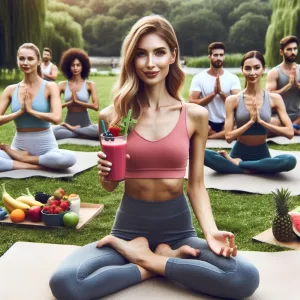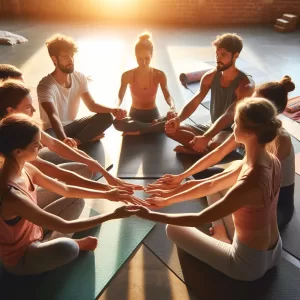Yoga, an ancient discipline transcending borders and eras, presents itself as a true art of living, harmonizing body, mind, and soul. In a quest for well-being and balance, this age-old practice offers a multitude of techniques, styles, and principles that meet the varied needs of everyone. Through the mastery of postures (asanas), breathing (pranayama), meditation, and much more, yoga invites deep self-exploration.
This article offers a comprehensive guide for beginners and advanced practitioners, exploring the foundations of yoga, its multiple benefits, practical advice, and the importance of nutrition and hydration. Enriched by the collective experience within the yoga community, this journey towards integral well-being reveals how yoga, well beyond a physical practice, becomes a life path.
I. Mastering Yoga Techniques: A Path to Harmony and Well-being.

Yoga, an ancient practice originating in India, is much more than just a series of physical postures. It is a complete discipline that integrates various techniques aimed at unifying the body, mind, and soul, thus promoting a state of overall well-being. Whether you’re a beginner or advanced, understanding and integrating these techniques can transform your yoga practice, providing you with unrivaled depth and richness. Here’s a look at fundamental yoga techniques that can enrich your journey toward balance and harmony.
1. Asanas: Body Postures.
Asanas, or yoga postures, are probably the most well-known aspect of yoga. They work on flexibility, strength, and balance while promoting the health and vitality of the body. Each posture has specific effects, helping to open, stretch, tone, or relax different parts of the body. Regular practice of asanas improves posture, reduces pain, and increases vital energy.
2. Pranayama: The Art of Breathing.
Pranayama, or breath control, is essential in the practice of yoga. It teaches how to become aware of our breath and regulate it through various techniques. Conscious breathing has a profound impact on our nervous system, reducing stress, improving concentration, and contributing to better emotional management. Incorporating pranayama into your practice can help you achieve a state of calm and mental clarity.
3. Dhyana: Meditation.
Meditation, or dhyana, is a central yoga practice that encourages peace of mind and presence. It involves focusing and observing thoughts without judgment, leading to greater self-awareness and inner peace. Meditation can reduce anxiety, improve emotional well-being, and promote a deeper sense of connection with oneself and the world.
4. Bandhas: Energy Locks.
Bandhas are techniques that involve “locking in” or controlling certain parts of the body to direct and regulate energy (prana) through energy channels. There are several main bandhas, and practicing them helps strengthen the core, improve posture, and intensify the effects of pranayama and meditation.
5. Mudras: Symbolic Gestures.
Mudras are gestures performed with the hands and fingers that aim to modify energy and the state of consciousness. Each mudra has a specific meaning and can influence the body, mind, and emotions in subtle ways. They are often used in conjunction with pranayama and meditation to deepen the practice.
6. Mantras: Sacred Sounds.
Mantras are sacred syllables, words, or phrases that are repeated as part of yoga practice. Their recitation acts on the mind by creating positive sound vibrations, facilitating concentration and meditation. Mantras can be a powerful tool for personal transformation.
7. Yamas and Niyamas: Ethical Principles.
The yamas and niyamas are ethical and moral principles that provide guidelines for how to live a life aligned with the values of yoga. The yamas focus on our interaction with others and the world, while the niyamas are about personal discipline and spiritual growth.
The practice of yoga offers a comprehensive path to wellness, integrating body, mind, and soul through a variety of techniques. By exploring and applying these techniques in your daily life, you can discover depth and richness in your yoga practice that goes far beyond the physical postures. Yoga is a path of personal and spiritual evolution that invites continuous exploration of oneself, towards greater inner peace, improved health, and harmony with the universe.
II. Exploring the Key Movements of Yoga: A Journey to Fluidity and Strength.

Yoga, with its wealth of postures and sequences, offers an exceptional journey towards balance and harmony between body and mind. At the heart of this age-old discipline are movements and transitions that, when executed with intention and awareness, can transform the practice into a truly transformative experience. Let’s discover together the key yoga movements that can enrich your practice, bringing you fluidity of movement and renewed inner strength.
1. Sun Salutations (Surya Namaskar):
Sun Salutations form a dynamic sequence of postures performed fluidly and synchronized with breathing. Ideal for warming up the body, they stimulate blood circulation and prepare muscles and joints for more intense practices. Surya Namaskar variations engage the whole body and can be adapted to all levels of practice.
2. Forward Bends (Uttanasana and Paschimottanasana):
Forward bends promote the length of the spine and the stretching of the back muscles. They help calm the mind and reduce stress by calming effect of the lowered head. By practicing these postures regularly, you can improve the flexibility of your body while promoting a moment of inner calm.
3. Back Bends (Bhujangasana and Ustrasana):
Backbends are powerful for opening the core and strengthening the spine. These movements improve posture and can relieve accumulated tension in the back. They also stimulate the abdominal organs, thereby promoting better digestion and revitalizing the entire body.
4. Standing Postures (Tadasana and Virabhadrasana):
Standing postures are fundamental to yoga practice because they teach alignment and stability. They strengthen the legs, improve balance, and support the development of a solid foundation for more complex postures. These asanas also cultivate a feeling of strength and grounding.
5. Twists (Ardha Matsyendrasana and Parivrtta Trikonasana):
Twists detoxify the body by massaging internal organs and stimulating circulation. They help release tension in the spine, improving mobility and flexibility. Twists also promote healthy digestion and can help relieve minor back pain.
6. Inversions (Sarvangasana and Adho Mukha Svanasana):
Inversions, where the heart is placed overhead, reverse blood flow and improve circulation. These invigorating postures strengthen the immune system, increase energy, and can have a rejuvenating effect on the body and mind. They also develop upper body strength and improve balance.
7. Balance Postures (Vrksasana and Bakasana):
Balance poses a challenge to concentration and coordination while strengthening and stabilizing muscles. They teach patience and perseverance, offering valuable lessons that extend far beyond the yoga mat.
Yoga movements are a universal language of healing, strength, and inner peace. By integrating these practices into your daily routine, you can not only improve your flexibility and physical strength but also cultivate greater mental and emotional resilience. Each posture, each transition, is an opportunity to connect deeply with yourself, explore the limits of your own body, and discover the perfect balance between effort and relaxation.
III. How to Choose the Right Style of Yoga?

Deciding to start yoga is the first step towards a journey of well-being and personal discovery. However, with the abundance of yoga styles available, choosing the one that best suits your needs and aspirations can seem like a daunting task. Whether you’re looking for a practice to strengthen your body, calm your mind, or perhaps a little of both, there is a style of yoga for you. Here’s a guide to help you navigate the world of yoga and select the style that will most resonate with your personal goals and fitness level.
1. Define Your Goals:
Before diving into the different styles of yoga, take a moment to think about what you want to achieve through your practice. Your goals may include:
– Improve flexibility and strength.
– Reduce stress and anxiety.
– Improve concentration and mental clarity.
– Find inner and spiritual balance.
– Recover from injury.
Identifying your goals will help you narrow down your choices and find the style of yoga that best aligns with your needs.
2. Assess Your Fitness Level:
Some styles of yoga are more physically demanding than others. Honestly assess your fitness level, taking into account any limitations you may have. If you’re a beginner or have specific health concerns, you might prefer to start with a gentler style and progress gradually.
3. Explore Different Styles:
– Hatha Yoga: Ideal for beginners, Hatha Yoga emphasizes basic postures and offers a good balance between bodywork and breathing techniques.
– Vinyasa Yoga: If you are looking for a dynamic practice that improves strength, flexibility, and endurance, Vinyasa, with its fluid movements synchronized with breathing, could be for you.
– Yin Yoga: For those who want to focus on deep connective tissue stretching and meditation, Yin Yoga offers a slower, meditative approach.
– Ashtanga Yoga: This style is suitable for people looking for an intense and rigorous practice, based on a series of postures performed in a specific order.
– Iyengar Yoga: If you want to improve your alignment and precision in postures, Iyengar, known for its use of accessories, may be right for you.
4. Consider Your Search for Mental Well-Being:
Yoga is not just a physical practice; it is also a path to inner peace. If your primary goal is to reduce stress and find serenity, styles like Restorative Yoga, Yin Yoga, or even some forms of Hatha Yoga, can be particularly beneficial.
5. Test Different Classes:
One of the best ways to find the style of yoga that suits you is to try different classes. Many studios offer introductory classes or discovery passes that allow you to experiment with several styles before committing.
6. Listen to Your Body and Your Heart:
Ultimately, choosing the ideal yoga style for you should be guided by your feelings and intuition. If practice makes you feel good in your body and mind, you’re probably on the right track.
Choosing the right type of yoga begins with introspection about your goals, assessing your fitness level, and openly exploring different practices. By following these steps and listening carefully to your body and heart, you will find the yoga path that resonates most deeply with you, opening the door to an enriching and transformative experience.
IV. Yoga Styles: To Choose The One That Suits You.

Yoga, with its rich diversity of practices, offers a range of varied styles, each with its particularities and benefits. Whether you’re looking for a gentle practice for relaxation or a dynamic session to improve your strength and flexibility, there is a style of yoga that meets your needs. Let’s explore some of the most popular styles of yoga to help you find the one that best resonates with your wellness path.
1. Hatha Yoga:
Hatha Yoga is often considered the foundation of all styles of yoga. This generic term designates any practice that combines postures (asanas), breathing techniques (pranayama), and meditation. Ideal for beginners, Hatha Yoga is practiced at a slow pace, allowing you to become familiar with the different postures while learning to control your breathing.
2. Vinyasa Yoga:
Vinyasa Yoga, known for its dynamic approach, is characterized by sequences of fluid postures punctuated by breathing. Each movement is synchronized with an inhalation or exhalation, creating a moving meditative practice. Suitable for those seeking both muscle strengthening and mental calming, Vinyasa offers an energizing and revitalizing experience.
3. Ashtanga Yoga:
Ashtanga Yoga is a rigorous and physically demanding style. Based on a fixed series of postures practiced in a specific order, this style is ideal for practitioners seeking a physical and mental challenge. Ashtanga develops strength, endurance, and concentration while promoting internal purification.
4. Iyengar Yoga:
Iyengar Yoga emphasizes precision and alignment in the execution of postures. Using various props like blocks, straps, and blankets, this style aims to adapt asanas to each body, making yoga accessible to everyone, including people with physical limitations. Iyengar is perfect for those who want to deepen their understanding of postures and improve their overall posture.
5. Bikram Yoga:
Also known as hot yoga, Bikram Yoga is practiced in a room heated to around 40°C with a humidity of 40%. This practice includes a series of 26 postures and two breathing exercises, performed in a specific order. Bikram is excellent for detoxification, muscle expansion, and weight loss.
6. Yin Yoga:
Yin Yoga is a gentle but intense practice that targets the body’s connective tissues, such as ligaments and fascia. The postures are held for long periods, often three to five minutes. This style is ideal for those looking to improve their flexibility and cultivate a deep meditative state.
7. Restorative Yoga:
Restorative Yoga is an extremely relaxing form of yoga where each posture is supported by props, allowing the body to completely relax effortlessly. This style is perfect for relieving stress, promoting healing, and allowing deep relaxation.
Each style of yoga has something unique to offer. By exploring different styles, you can discover the one or styles that most resonate with your physical, mental, and spiritual needs. Remember that yoga practice is a personal journey; what matters most is to listen to your body and mind, and enjoy the journey towards a more balanced and harmonious life.
V. The Benefits of Yoga:

1. Improved Flexibility and Strength:
Yoga poses stretch your muscles and can significantly increase your range of motion. Over time, the postures become easier to perform, and you will notice an improvement in your strength.
2. Stress Reduction and Improved Mental Health:
Yoga is recognized for its beneficial effects on mental health, particularly through the practice of meditation and deep breathing which promote relaxation and reduce stress.
3. Improved Posture and Reduced Pain:
Regular practice helps strengthen the core muscles, thereby improving posture. It can also help reduce pain related to poor postural habits.
4. Strengthening the Immune System:
By reducing stress, yoga can help strengthen the immune system, making you less susceptible to illness.
5. Improved Breathing:
Yoga places particular emphasis on breathing techniques, or pranayama, which can improve lung capacity, breathing quality, and stress management. Learning to breathe deeply and consciously can have a calming effect on the central nervous system.
6. Increased Concentration and Mental Clarity:
Practicing yoga promotes concentration and mindfulness, helping to calm the constant chatter of the mind. This can improve mental clarity, memory, and the ability to concentrate, beneficial in both personal and professional life.
7. Strengthening Self-Confidence:
By focusing on the present moment and progressing through the different postures, yoga can help develop a better self-image and increase confidence. Regular practice encourages self-acceptance and respect for your body.
8. Promoting Better Quality Sleep:
Yoga can improve the quality of sleep thanks to its calming effects on the nervous system. Relaxation and meditation techniques are especially helpful for those who struggle with insomnia or disturbed sleep.
9. Support for Weight Management:
Although yoga is not primarily an exercise focused on weight loss, it can help regulate metabolism and reduce levels of the stress hormone cortisol, which is often linked to weight gain. Additionally, yoga encourages a deeper connection with the body, which can help lead to better eating habits.
10. Improved Digestion:
Yoga movements and postures can help stimulate the digestive system, thereby improving digestion and helping to relieve digestive problems such as constipation and irritable bowel syndrome.
11. Strengthening Cardiovascular Health:
Regular yoga practice can help reduce blood pressure, improve blood circulation, and lower heart rate, all of which are beneficial for cardiovascular health.
12. Reduction of Inflammation:
Studies suggest that yoga can reduce inflammation in the body, which is beneficial because chronic inflammation is linked to various chronic diseases, such as heart disease, diabetes, and cancer.
13. Hormonal Balance:
Yoga can help balance the body’s endocrine systems, regulating hormones and improving mood and overall well-being.
14. Recovery Support:
Yoga can be particularly beneficial for physical and mental recovery, especially after injuries, by providing low-impact exercises that help rebuild strength and flexibility.
Yoga, by its holistic nature, touches all aspects of being. Whether you are just starting or have been practicing for years, each session is an opportunity to discover new dimensions of well-being.
VI. Tips for Beginners:

Here is a version of the tips for yoga beginners for better understanding and application:
1. Choose the Right Yoga Style:
Yoga comes in a variety of styles, each with its particularities. For beginners, it is crucial to choose a style that matches their current physical abilities and aspirations. For example, “Hatha Yoga” is often recommended to novices for its slow pace and focus on basic postures, which allows for a better understanding of body alignments. Conversely, “Vinyasa Yoga” is characterized by a more dynamic sequence and could be suitable for those looking for more physical practice. Learn about the different styles, and don’t hesitate to try several classes to find the one that suits you best.
2. Practice Regularly:
Regular practice is essential to fully benefit from the effects, both physically and mentally. Commit to a routine, practicing two to three times a week. This consistency not only improves flexibility, strength, and balance but also reduces stress and improves concentration. Even short sessions of 20 minutes can be beneficial if done regularly.
3. Listen to Your Body:
One of the central philosophies is listening to and respecting your own body. Each individual is unique, and abilities vary from person to person. Pay attention to your body’s signals and adjust your practice accordingly. The use of props, such as blocks, straps, or cushions, can help modify postures for your comfort and safety.
Remember: the goal is to progress at your own pace, without pain or discomfort.
4. Join a Community:
Although yoga can be practiced alone, joining a community or attending group classes can greatly enrich your experience. Classes led by experienced instructors offer valuable guidance and personalized corrections that can make a big difference in your practice. Additionally, being surrounded by other practitioners can serve as motivation and inspiration.
5. Be Patient and Perseverant:
Yoga is a personal journey that unfolds over the long term. Progress can be slow and subtle, so patience and persistence are essential. Each session is an opportunity to explore and connect more with yourself. Celebrate small improvements, like holding a posture a little longer or feeling an improvement in your breathing. Over time, these small victories add up to transform your practice and, potentially, your life.
Yoga is a powerful practice capable of transforming your life positively, providing harmony between body and mind. Whether you’re looking to improve your flexibility, reduce stress, or simply find a moment of peace in your busy day, yoga has a lot to offer. Remember, the yoga journey is personal and unique to each person. Take the time to discover what works best for you, and enjoy every moment spent on your mat.
VII. Diet and yoga:

Integrating a conscious and balanced diet is essential to support and enrich your yoga practice because what you consume has a direct impact on your energy, flexibility, and endurance. Here is a detailed approach that combines nutrition and yoga, with an emphasis on the principles of Ayurveda, a holistic health system that often complements yoga practice.
1. Principles of Ayurveda in Yoga Practice:
Ayurveda, the science of life, is a system of traditional medicine originating in India that emphasizes a balance between the body, mind, and environment. According to Ayurveda, we are made up of three doshas (energy types): Vata, Pitta, and Kapha. Identifying your dominant dosha can help you tailor your diet to support your yoga practice and overall well-being.
– Vata (air and ether elements): Favor warming, moist, and stable foods to counter the lightness and dryness of Vata. Soups, cooked grains, and root vegetables are beneficial.
– Pitta (fire and water elements): Favor fresh, soft, and cold foods to balance the heat of Pitta. Fresh fruits and vegetables, dairy products, and whole grains are recommended.
– Kapha (water and earth elements): Opt for light, dry, and warm foods to compensate for the heaviness and humidity of Kapha. Green vegetables, legumes, and spices like ginger and black pepper are ideal.
2. Foods to Support Yoga Practice:
– Foods for Flexibility:
A diet rich in omega-3 can help improve joint flexibility. Chia seeds, walnuts, and fatty fish like salmon are excellent sources of omega-3. Antioxidant-rich fruits and vegetables, such as berries and spinach, may also contribute to connective tissue health.
– Foods for Endurance:
Complex carbohydrates provide a sustainable source of energy for your yoga practice. Whole grains, such as quinoa, oats and brown rice, are excellent choices. Pair them with quality proteins, like lentils and chickpeas, to support muscle repair and growth.
3. Dietary Strategies for Flexibility and Endurance:
– Optimization of Nutrients for Flexibility:
In addition to omega-3, incorporating foods rich in vitamin C and magnesium, such as citrus fruits and nuts, can promote collagen production and muscle relaxation, improving flexibility.
– Food Synergy for Endurance:
Combine protein with antioxidants for optimized muscle recovery. For example, a smoothie made with berries (antioxidants) and protein powder can be a great post-practice drink.
– Dynamic Hydration:
Vary hydration sources. Water infused with cucumber or mint can improve absorption and add natural electrolytes, supporting deep hydration and better circulation of prana energy.
– Daily Integration:
•Meal Planning:
Plan meals and snacks that align your diet with natural cycles and your Ayurvedic constitution. For example, a hearty lunch and a light dinner are in harmony with the natural rhythm of Agni.
•Food Meditation and Mindfulness:
Incorporate mindfulness into the way you eat, taking time to savor each bite, which can improve digestion and assimilation while promoting a more harmonious relationship with food.
Diet and yoga are closely linked in the quest for balance and overall well-being. By adopting a mindful approach to your diet, in harmony with the principles of Ayurveda, you can support and enrich your yoga practice, promote your physical and emotional health, and improve your quality of life.
Start with small changes, listen to your body, and adjust your diet based on what makes you feel best, both on the yoga mat and in your daily life.
VIII. The Importance of Hydration:

Hydration plays a crucial role in yoga practice, especially for more intense styles such as Bikram or hot yoga, where the high temperature can lead to profuse sweating and increase the risk of dehydration.
Here’s a look at the importance of hydration and tips for hydrating properly:
1. The Importance of Hydration:
Hydration is fundamental for the proper functioning of the body, especially when practicing a physical activity such as yoga. Muscles made up of more than 70% water, require adequate hydration to function properly and prevent fatigue, headaches, and imbalance. Indeed, drinking enough water helps regulate body temperature, maintain energy levels, and aid recovery after exercise.
2. Tips for Optimal Hydration:
For optimal hydration around yoga practice, adopting a structured approach before, during, and after your sessions can make all the difference in your performance and general well-being. Here’s a deeper exploration of each tip given, with additional explanations to help you understand their importance and integrate them effectively into your routine.
– Before Yoga:
Starting your yoga practice well-hydrated is essential. Consuming between 250 and 500 ml of water approximately 2 hours before your session ensures that your body has time to absorb water and prevents any dehydration or discomfort during practice. Proper prior hydration supports blood circulation, which improves oxygenation and delivery of nutrients to the muscles, increasing your performance and preventing cramps.
– During Yoga:
Consuming water regularly during your practice, at a rate of 60 ml every 20 minutes, helps to compensate for fluid loss due to sweating, especially in an intense or heated yoga class. Keeping a water bottle on hand allows you to easily hydrate without significantly interrupting your practice. It is crucial to drink in small sips to avoid the feeling of heaviness or discomfort that could hamper your movements or concentration.
– After Yoga:
Post-practice rehydration is as crucial as preparation. Drinking 200-300ml of water after your session helps replenish lost fluids, supports muscle recovery, and can help reduce soreness. This is particularly important after intensive practices or in hot conditions where sweating is more profuse.
– Listen to your body:
Each person has unique hydration needs, which can vary depending on factors such as activity level, climate, and general health. Learning to listen to your body and recognize the signs of thirst is essential to maintaining adequate hydration without overhydrating.
– Diversify Your Hydration:
Varying the types of drinks can make hydration more enjoyable and effective. Herbal teas and electrolyte-enriched drinks are great alternatives to water, offering additional benefits like supporting digestion and replenishing lost electrolytes. This can be particularly useful after intensive practices or in hot weather.
– Prepare Your Drinks at Home:
Making your hydration drinks allows you to control the ingredients and avoid added sugars and additives found in many commercial drinks. Water infused with fresh fruit, herbs, or herbal teas can provide refreshing, nutritious hydration without the drawbacks of sugary drinks.
These tips, when integrated consistently into your yoga routine, can significantly improve your practice, recovery, and overall well-being. Adequate hydration not only supports your physical performance but also contributes to better concentration and a more enriching yoga experience.
3. Hydration and Hot Yoga Styles:
In the case of practices like Bikram or hot yoga, where the temperature can reach between 90 and 105 degrees Fahrenheit, hydration becomes even more critical. Excessive sweating leads to a significant loss of water, electrolytes, and minerals, increasing the risk of dehydration. To avoid this, drink water before, during (if necessary), and especially after practice. Also, consider sports drinks to replenish lost electrolytes.
4. Recommended drinks and drinks to avoid:
For optimal hydration when practicing yoga or any other physical activity, it is important to choose the right drinks. Water remains the best option for rehydration, but other drinks can also be beneficial, especially for more intense sessions or in high-heat conditions. Here is a detailed exploration of recommended drinks, enriched with suggestions for varying your hydration while avoiding common pitfalls.
• Recommended drinks:
Herbal teas:
– Benefits: Herbal teas are ideal for hydrating yourself while benefiting from their calming or revitalizing properties. They can help relax the mind and body after a yoga session, promoting better recovery.
– Suggestions: Herbal teas made from chamomile, mint, or ginger are particularly appreciated for their soothing and digestive effects. For a dose of caffeine-free energy, opt for ginseng or rooibos.
Electrolyte Fortified Drinks:
– Benefits: Electrolyte drinks help replenish minerals lost through sweat, such as sodium, potassium, and magnesium, essential for proper muscle function and fluid balance.
– Suggestions: Choose low-sugar drinks or homemade coconut water, which is naturally rich in electrolytes and healthier than many store-bought drinks.
• Drinks to Avoid
– Alcohol:
Alcohol is a diuretic, meaning it can cause you to become dehydrated more quickly by increasing urine production. This can compromise your recovery after a yoga session and negatively affect your fluid balance.
– Caffeinated Drinks:
Although caffeine in small amounts is not necessarily harmful, excessive consumption can also contribute to dehydration. Beverages like coffee, black tea, and some sodas can increase dehydration, especially when consumed in large quantities.
In summary, hydration is essential for safe and effective yoga practice, especially in hot conditions which increase sweating and the risk of dehydration. Following these hydration tips will help you get the most out of your yoga practice while staying healthy.
IX. The place of community in the practice of yoga:

The place of community in yoga practice is an often underestimated, but deeply enriching aspect. Joining a yoga community, whether online or locally, offers an additional dimension to this age-old practice, transforming an individual routine into a shared experience. Here’s a detailed exploration of how engaging with a yoga community can deepen and enrich your practice.
1. The Benefits of a Yoga Community:
– Support and Motivation:
One of the greatest strengths of a community is the mutual support it provides. Practicing yoga can sometimes be daunting, especially when you encounter physical or mental obstacles. Having a community allows you to exchange advice, experiences, and support, thus encouraging perseverance and motivation. This is especially true in online yoga groups, where members can share their progress, ask questions, and receive encouragement around the clock.
– Continuous Learning:
The yoga community is an inexhaustible source of knowledge. From workshops to classes to informal chats, every interaction is an opportunity to learn something new. This may involve posture adjustments, yoga philosophy, breathing techniques, or even nutritional advice promoting a more balanced practice. Learning within a community also promotes a holistic approach to yoga, integrating its various aspects well beyond physical postures.
– Inspiration:
Seeing the progress of others can be incredibly inspiring. Yoga communities, especially online ones, provide a window into the personal journeys of people around the world. It can inspire you to try new postures, persevere with daily practice, or even explore the spiritual and meditative aspects. Inspiration can also come from observing the commitment and passion of other community members, serving as a motivating reminder of the importance of the practice.
– Human Connection:
At the heart of yoga practice is the quest for union – with oneself, with others, and with the universe. Yoga communities provide a space for this connection, allowing for shared common experiences that often transcend simple poses on a mat. Whether at a yoga retreat, a local group class, or an online discussion, human connection enriches the practice of yoga by integrating a deep emotional and spiritual dimension.
2. How to Join a Yoga Community?
• Locally:
– Yoga Classes and Workshops: Look for local yoga studios that regularly host classes, workshops, and community events.
– Practice Groups: Some communities have yoga practice groups that meet regularly in parks, community centers, or in private homes.
– Yoga Events and Festivals: Attending yoga festivals is a great way to meet like-minded yogis and learn from experienced teachers.
• Online:
– Forums and Discussion Groups: Platforms like Reddit, Facebook, and dedicated yoga forums can provide a sense of community and a space for sharing information and support.
– Online Yoga Classes: Many platforms offer online classes with community spaces for their members, allowing them to discuss practices, challenges, and successes.
Engaging with a yoga community enriches the practice by providing support, lifelong learning, inspiration, and deep human connection. By exploring different ways to join a community, whether online or locally, you can find a source of enrichment and fulfillment in your yoga journey.
XX. Safety and injury prevention:

Safety and injury prevention are fundamental aspects of yoga practice, allowing practitioners of all levels to fully benefit from the benefits of this age-old discipline without risk. Taking a careful and informed approach is crucial to avoiding common injuries associated with yoga practice. Here are essential tips for practicing yoga safely, highlighting the importance of listening to your body and adjusting postures according to your limits.
1. Listen to Your Body:
Self-observation is the key to injury prevention. Pay attention to your body’s signals and differentiate beneficial stretching sensations from pain signaling a problem. If a posture causes sharp or uncomfortable pain, adjust your position or use yoga props to make it more accessible.
2. Practice with Attention:
Mindfulness and focusing on the present moment increases body awareness and reduces the risk of injury. Pay close attention to the alignment of your body in each posture and perform the movements in a controlled manner, avoiding abrupt or rushed actions.
3. Warm Up Properly:
Starting your session with a warm-up helps prepare the body for more demanding postures. Gentle, gradual movements increase body temperature and blood circulation, making muscles more flexible and reducing the risk of injury.
4. Use Yoga Accessories:
Blocks, straps, and pads aren’t just for beginners; they are excellent tools for yogis of all levels to support, deepen, or adopt a posture. Using accessories can help maintain proper alignment and avoid unnecessary strain.
5. Don’t Force:
Respect your limits and accept that flexibility and strength increase over time. Forcing your body into a posture can cause more harm than good. If you can’t achieve a full pose, focus on a modified version, and gradually work toward a greater range of motion.
6. Prioritize Alignment over Depth:
Correct alignment is more beneficial than posture depth. A well-aligned posture ensures a balanced distribution of force and minimizes the risk of stress on joints, muscles, and ligaments.
7. Practice Regularly but in Moderation:
Regular practice promotes progress, but it is important to allow your body to rest. Rest days are essential for muscle recovery and preventing exhaustion and overuse injuries.
8. Pay Attention to Transitions:
Transitions between postures can be as challenging as the postures themselves. Pay attention to how you move your body from one posture to the next, maintaining proper muscle engagement and alignment to avoid awkward movements.
By integrating these principles of safety and injury prevention into your yoga practice, you create a strong foundation for a healthy, lasting yoga journey. Remember that yoga is a personal practice, and competition or comparison with others should never compromise your physical well-being.
XXI. The long-term benefits:

The long-term benefits of yoga offer an enriching perspective on how this ancestral practice transcends the simple framework of physical activity to become a true art of living, positively influencing the physical and mental health of its followers.
1. Improved Mental Health:
Yoga, practiced regularly, can become a powerful tool in managing stress and anxiety. In the long term, it promotes better emotional regulation, contributing to a significant reduction in symptoms of depression and anxiety. This practice also helps to develop an attentive presence (mindfulness), thus improving the quality of life.
2. Muscle Strengthening and Flexibility:
Beyond the immediate benefits felt after a session, yoga contributes, in the long term, to deep muscle strengthening and improved flexibility. These cumulative effects can reduce the risk of injury, relieve chronic pain, especially in the back, and improve posture.
3. Cardiovascular Health:
Regular yoga practice is associated with lower blood pressure and improved cardiovascular health. These long-term beneficial effects may reduce the risk of heart disease and stroke.
4. Harmonal Balance:
Yoga can positively influence hormonal balance, particularly through the reduction of cortisol, the stress hormone. This regulation can have beneficial effects on various aspects of health, such as sleep cycle, weight, and metabolism.
5. Improved Breathing:
Breathing techniques (Pranayama) practiced in yoga enrich lung capacity and improve respiratory efficiency. In the long term, this can contribute to better oxygenation of the body, vital for general well-being.
6. Awareness and Mind-Body Connection:
Yoga promotes a deep connection between body and mind, helping individuals develop a heightened awareness of their physical and mental state. This awareness can lead to better lifestyle choices, positively influencing long-term health.
7. Impact on Sleep Quality:
Regular yoga practice can significantly improve sleep quality. By reducing stress and promoting relaxation, yoga helps combat insomnia and promote restful sleep.
By incorporating these elements into your content, you will provide your readers with a comprehensive, in-depth perspective on the long-term benefits, not only as a physical practice but also as a path to overall, lasting wellness.
Conclusion:
Yoga proves to be a rich and profound practice, offering much more than just physical improvement. By integrating the techniques, styles, and principles of yoga into our lives, we embark on a path of personal and collective transformation. Conscious eating, adequate hydration, and the support of a community are all pillars that enrich our practice. Yoga teaches us patience, perseverance, and listening to ourselves, gradually leading us toward a state of complete well-being. As we continue to explore and practice, it is important to remember that each day offers a new opportunity for growth and learning. Yoga is not just a set of postures on a mat; it is a path to a balanced, healthy, and harmonious life.

